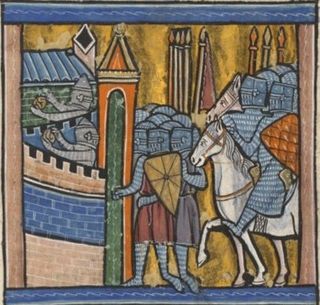 W
WThe Alexiad is a medieval historical and biographical text written around the year 1148, by the Byzantine princess Anna Komnene, daughter of Emperor Alexios I Komnenos. It was written in a form of artificial Attic Greek. Anna described the political and military history of the Byzantine Empire during the reign of her father, thus providing a significant account on the Byzantium of the High Middle Ages. Among other topics, the Alexiad documents the Byzantine Empire's interaction with the Crusades and highlights the conflicting perceptions of the East and West in the early 12th century. It remains one of the few primary sources recording Byzantine reactions to both the Great Schism of 1054 and the First Crusade, as well as documenting firsthand the decline of Byzantine cultural influence in both eastern and western Europe. According to Peter Frankopan, the content of the Alexiad falls into five main categories.
 W
WThe Crusader attack on Blachernae was a skirmish that took place during the Crusade of 1101. As in the First Crusade, the pilgrims and soldiers of 1101 crusade did not leave as a part of one large army, but rather in several groups from various different regions from across Western Europe. In September 1100, a large group of Lombards left from Milan. These were mostly untrained peasants, led by Anselm IV, Archbishop of Milan. When they reached the territory of the Byzantine Empire, they recklessly pillaged the countryside in want of food and provisions until the Byzantine emperor Alexios I, possibly under force of arms, escorted them to a camp outside Constantinople. This did not satisfy them for long, as they forced their way inside the city where they pillaged the Blachernae palace, even killing Alexios' pet lion. In order to limit any further damage, the Lombards were quickly ferried across the Bosporus and made their camp at Nicomedia, to wait for additional Crusading reinforcements.
 W
WWars between the Normans and the Byzantine Empire were fought from c. 1040 until 1185, when the last Norman invasion of the Byzantine Empire was defeated. At the end of the conflict, neither the Normans nor the Byzantines could boast much power as by the mid-13th century, exhaustive fighting with other powers had weakened both, leading to the Byzantines losing Asia Minor to the Ottoman Empire in the 14th century, and the Normans losing Sicily to the Hohenstaufen.
 W
WKykkos Monastery, which lies 20 km west of Pedoulas, is one of the wealthiest and best-known monasteries in Cyprus.
 W
WThe Monastery of Komnenion is an Eastern Orthodox monastery located near Stomio, Larissa, Greece.
 W
WThe siege of Nicaea was the first major battle of the First Crusade, taking place from 14 May to 19 June 1097. The city was under the control the Seljuk Turks who opted to surrender to the Byzantines in fear of the crusaders breaking into the city. The siege was followed by the Battle of Dorylaeum and the Siege of Antioch, all taking place in modern Turkey.
 W
WThe Panagia Episkopi is the previous middle-Byzantine cathedral of the Greek Cycladean island of Santorini (Thira). It is also called Panagia tis Episkopis or Church of Episkopi Thiras. According to a traditional, now almost completely destroyed inscription, the church building was commissioned by the Byzantine Emperor Alexios I Komnenos at the end of the 11th century, and took the place of a previous three-aisled early Byzantine basilica. The church was dedicated to the Panagia ("All-holy"), a Greek Orthodox appellation for the Virgin Mary. The second part of the name (Episkopi) means "episcopal". The Panagia Episkopi was the seat of the Orthodox diocese of Santorini until 1207 and from 1537 to 1827.